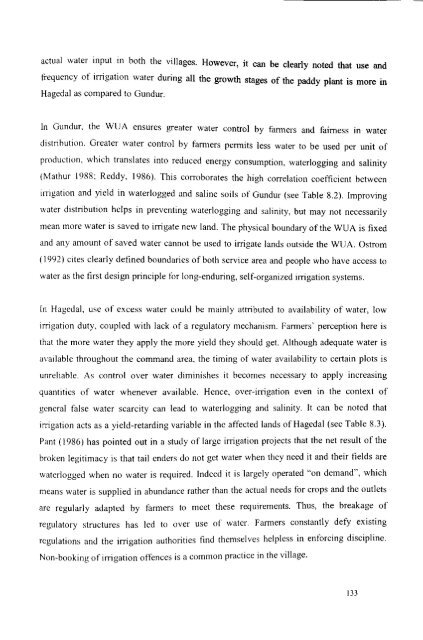Water Users Association and Irrigation Management - Institute for ...
Water Users Association and Irrigation Management - Institute for ...
Water Users Association and Irrigation Management - Institute for ...
You also want an ePaper? Increase the reach of your titles
YUMPU automatically turns print PDFs into web optimized ePapers that Google loves.
actual water input in both the villages. However, it can be clearly noted that use <strong>and</strong><br />
frequency of irrigation water during all the growth stages of the paddy plant is more in<br />
Hagedal as compared to Gundur.<br />
In Gundur, the WU A ensures greater water control by farmers <strong>and</strong> fairness in water<br />
distrihution. Greater water control by farnlers permits less water to be used per unit of<br />
production, which translates into reduced energy consumption, waterlogging <strong>and</strong> salinity<br />
(Mathur 19RR; Reddy, 1986). This corroborates the high correlation coefficient between<br />
irrigation <strong>and</strong> yield in waterlogged <strong>and</strong> saline soils of Gundur (see Table 8.2). Improving<br />
water distribution heIps in preventing waterlogging <strong>and</strong> salinity, but may not necessarily<br />
mean more water is saved to irrigate new l<strong>and</strong>. The physical boundary of the WUA is fixed<br />
<strong>and</strong> any amount of saved water cannot be used to irrigate l<strong>and</strong>s outside the WUA. Ostrom<br />
(1992) cites clearly defined boundaries of both service area <strong>and</strong> people who have access to<br />
water as the first design principle <strong>for</strong> long-enduring, self-organized irrigation systems.<br />
In Hagedal, use of excess water could be mainly attributed to availability of water, low<br />
irrigation duty. coupled with lack of a regulatory mechanism. Farmers' perception here is<br />
that the more water they apply the more yield they should get. Although adequate water is<br />
avaIlable throughout the comm<strong>and</strong> area, the timing of water availability to certain plots is<br />
unreliable. As control over water diminishes it becomes necessary to apply increasing<br />
quantities of water whenever available. Hence, over-irrigation even in the context of<br />
general false water scarcity can lead to waterlogging <strong>and</strong> salinity. It can be noted that<br />
irrigation acts as a yield-retarding variable in the affected l<strong>and</strong>s of Hagedal (see Table 8.3).<br />
Pant (1986) has pointed out in a study of large irrigation projects that the net result of the<br />
broken legitimacy is that tail enders do not get water when they need it <strong>and</strong> their fields are<br />
waterlogged when no water is required. Indeed it is largely operated "on dem<strong>and</strong>", which<br />
means water is supplied in abundance rather than the actual needs <strong>for</strong> crops <strong>and</strong> the outlets<br />
are rei:,'lIlarly adapted by farmers to meet these requirements. Thus, the breakage of<br />
regulatory structures has led to over use of water. Farmers constantly defy existing<br />
regulations <strong>and</strong> the irrigation authorities find themselves helpless in en<strong>for</strong>cing discipline.<br />
Non-booking of irrigation offences is a common practice in the village.<br />
133
















